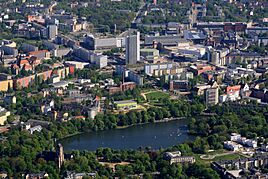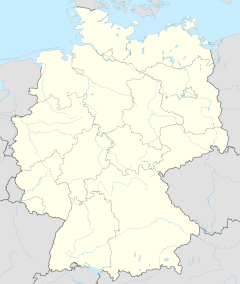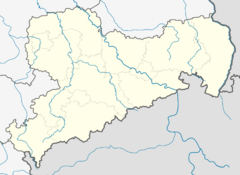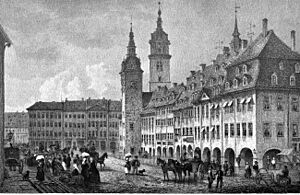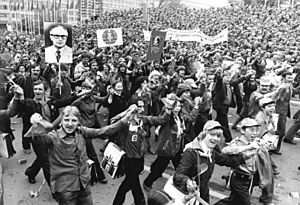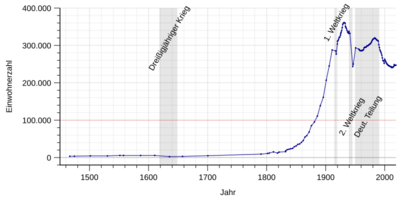Chemnitz facts for kids
Quick facts for kids
Chemnitz
|
|||
|---|---|---|---|
|
View over Chemnitz
Theater Chemnitz
New city hall
Petrikirche
Karl Marx Monument
Rabenstein
|
|||
|
|||
| Country | Germany | ||
| State | Saxony | ||
| District | Urban district | ||
| Area | |||
| • Total | 220.85 km2 (85.27 sq mi) | ||
| Elevation | 296 m (971 ft) | ||
| Population
(2022-12-31)
|
|||
| • Total | 248,563 | ||
| • Density | 1,125.483/km2 (2,914.99/sq mi) | ||
| Time zone | UTC+01:00 (CET) | ||
| • Summer (DST) | UTC+02:00 (CEST) | ||
| Postal codes |
09001–09247
|
||
| Dialling codes | 0371
037200 (Wittgensdorf) 037209 (Einsiedel) 03722 (Röhrsdorf) 03726 (Euba) |
||
| Vehicle registration | C | ||
Chemnitz is a large city in Germany. It is the third-largest city in the state of Saxony, after Leipzig and Dresden. From 1953 to 1990, it was called Karl-Marx-Stadt.
The city is located in a busy area near the Ore Mountains. It sits on the Chemnitz River, which is formed by two smaller rivers, the Zwönitz and Würschnitz. The name "Chemnitz" comes from a Slavic word meaning "stone."
Chemnitz is known for its many old industrial buildings. It was chosen as the European Capital of Culture for 2025. The city's economy focuses on services and manufacturing. Chemnitz University of Technology is a big university here, with about 10,000 students.
Contents
What's in a Name?
Chemnitz gets its name from the Chemnitz River. The word "Chemnitz" comes from an old Slavic word for "stone" (kamjeń). This is why the river was called Kamjenica, meaning "stony brook."
Many places around the world have names that come from this same Slavic word for "stone." Chemnitz is the largest city among them.
A Look Back: Chemnitz History
The area where Chemnitz is today was first settled by Slavic tribes. The river's name was recorded as "Caminizi" as early as 1012. In 1143, a monastery was built, and a town grew around it. Around 1170, Chemnitz became a "free imperial city," which meant it was directly under the Holy Roman Emperor.
From Textiles to Industry
In 1307, Chemnitz became part of the Margraviate of Meissen. During the Middle Ages, it became famous for making and trading textiles. Many people worked in this industry.
A famous geologist named Georgius Agricola lived in Chemnitz from 1533 until his death in 1555. He was the city doctor and even served as mayor several times.
By the early 1800s, Chemnitz grew into a major industrial center. It was sometimes called "the Saxon Manchester" because it was so important for industry. Many important companies started here. By 1913, Chemnitz had over 320,000 people.
After World War I
After the First World War, Chemnitz was a strong center for socialist groups because of its many working-class people. In 1932, Auto Union (which later became Audi) was founded in Chemnitz.
World War II and Rebuilding
During the Second World War, Chemnitz had factories that made military equipment. The city was heavily bombed by Allied forces, and much of its center was destroyed. About 41% of the city's built-up area was ruined.
After the war, Soviet troops took over the city in May 1945. The headquarters of Auto Union were badly damaged, and the company moved to Ingolstadt, Bavaria, becoming Audi.
The city center was rebuilt after the war, especially during the time of East Germany. Many new apartment buildings were constructed.
The Karl Marx City Era
In 1953, the East German government renamed the city Karl-Marx-Stadt (Karl Marx City). This was to honor Karl Marx and the city's industrial past. The Prime Minister at the time, Otto Grotewohl, said the city looked forward to a "new and better future" under socialism.
During this period, the city center was redesigned to fit the idea of a socialist city. Many old buildings were replaced with new apartment blocks.
After German Reunification
On April 23, 1990, people in Chemnitz voted on the city's name. 76% voted to go back to the old name, "Chemnitz." So, on June 1, 1990, the city was officially renamed.
After Germany reunited in October 1990, Chemnitz faced new challenges. Many people moved to West Germany, and unemployment increased. The city also needed more modern shops. Large shopping centers were built around the city.
The city center was re-planned and rebuilt. Many new buildings were constructed, including modern department stores and shops.
In late August 2018, Chemnitz saw a series of protests. A concert called "We are more" was held a week later, attracting many people to stand against hate.
Culture and Fun Things to See
Chemnitz was chosen as a European Capital of Culture for 2025. This means it will host many special events and shows.
Theater Chemnitz offers different kinds of performances, like opera, plays, and ballet. The city's orchestra, Robert-Schumann-Philharmonie, also plays here.
Famous Sights
- The Kassberg neighborhood has beautiful buildings from the 1700s and 1800s.
- The Karl Marx Monument is a large bust of Karl Marx, often called "Nischel" (a local word for head) by people in Chemnitz.
- The Old Town Hall has a Renaissance-style entrance from the 1400s.
- The Red Tower is a very old landmark, built in the late 1100s or early 1200s as part of the city wall.
- The Chemnitz petrified forest is a very rare collection of ancient trees turned to stone. You can see it at the Kulturkaufhaus Tietz.
- Rabenstein Castle is the smallest castle in Saxony.
The city center has changed a lot since reunification. It now has many shops and large shopping centers with international brands. The Galerie Roter Turm (Red Tower Gallery) is a popular shopping spot.
Museums and Gardens
- The Chemnitz Industrial Museum shows the city's industrial past.
- The State Museum of Archaeology Chemnitz opened in 2014 in a historic department store building.
- The Museum Gunzenhauser has a large collection of modern art, including works by famous artists like Otto Dix.
- The Museum am Theaterplatz is another great art museum.
- The Botanischer Garten Chemnitz is a city botanical garden.
- The Arktisch-Alpiner Garten der Walter-Meusel-Stiftung specializes in plants from arctic and alpine regions.
- The Villa Esche is a beautiful historic house built in 1902 in the Art Nouveau style.
Chemnitz also hosts the SCHLINGEL International Film Festival every year, which focuses on movies for young people.
Image gallery
-
Bust of Karl Marx, the city's former namesake
-
Gründerzeit quarter Kaßberg
Chemnitz Weather
Chemnitz has a mild climate. It gets about 732.7 mm (28.8 inches) of rain each year. Summer usually has about twice as much rain as winter.
The highest temperature ever recorded in Chemnitz was 37.8°C (100.0°F) on August 20, 2012. The lowest was -28.4°C (-19.1°F) on February 11, 1956.
How Chemnitz is Organized
Chemnitz is divided into 39 neighborhoods. Some of these, like Einsiedel and Euba, used to be separate towns before they joined Chemnitz. These special neighborhoods have their own local councils.
The neighborhoods are numbered in a clockwise direction, starting from the city center.
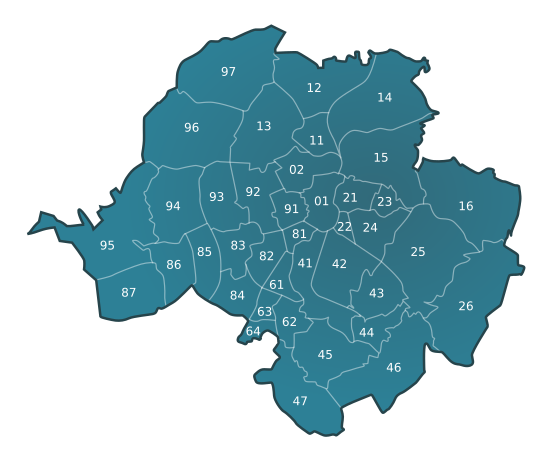
¹ also a locality |
City Leadership
The mayor of Chemnitz is Sven Schulze, who was elected in 2020. Before him, Barbara Ludwig was mayor from 2006 to 2020. The mayor is chosen by the people of Chemnitz in an election.
The city council is made up of members from different political parties. The most recent election for the city council was held on June 9, 2024.
Chemnitz Economy
Chemnitz is a very important economic area in eastern Germany. In 2016, its economy produced €8.456 billion. The city's economy has been growing quickly since 2000.
Many medium-sized companies are based here. The main industries are mechanical engineering, metal processing, and making vehicles. About 100,000 people work in Chemnitz. Many of them travel from nearby towns.
Image gallery
-
Volkswagen is a major employer in the Chemnitz area.
-
Chemnitz is a central point for tourism in the Ore Mountains.
Population Changes
Chemnitz has about 246,000 people, making it the 3rd largest city in Saxony. Its population grew very fast in the early 1900s because of its industries. In 1930, it reached its highest population ever, with about 362,000 people.
During the East German era, when it was called "Karl-Marx-Stadt," it was a big industrial city. After Germany reunited, Chemnitz's population dropped a lot. From 1989 to 2003, it lost about 20% of its people.
However, in the 2010s, the population started to grow again. This was partly due to people moving there from other countries.
Languages Spoken
- Standard German
- Chemnitz dialect, which is a local way of speaking Upper Saxon German.
Getting Around Chemnitz
Roads and Highways
Chemnitz is connected to two major highways, the A4 (from Erfurt to Dresden) and the A72 (from Hof to Leipzig). The A4 is part of the European route E40, a very long road that connects Chemnitz to France in the west and even to Asia in the east.
Public Transportation
The city has a good public transport system with trams and buses. It also has a special light rail system called the Stadtbahn. There is one Stadtbahn line, five tram lines, and 27 city bus lines.
Chemnitz Hauptbahnhof is the main train station. In June 2022, a direct train connection from Chemnitz to Rostock-Warnemünde (via Dresden and Berlin) was started again. This was important because for a long time, Chemnitz was the biggest German city without a direct long-distance train service.
Airports
Two international airports are close to Chemnitz: Leipzig/Halle Airport and Dresden Airport. Both are about 70 km (43 miles) away and offer many flights.
Chemnitz also has a small local airport called Flugplatz Chemnitz-Jahnsdorf, about 13.5 km (8.4 miles) south of the city.
Sports in Chemnitz
Chemnitz is home to many sports teams and clubs. Here are some of them:
- BV Chemnitz 99 (basketball, men's team)
- Chemnitzer FC (football/soccer)
- Chemcats Chemnitz (basketball, women's team)
- VfB Fortuna Chemnitz (football/soccer)
- Post SV Chemnitz (swimming)
- Schwimmclub Chemnitz v. 1892 e.V. (swimming)
- ERC Chemnitz e.V. (ice hockey, skater hockey)
- Chemnitz Crusaders (American football)
- Tower Rugby Chemnitz (rugby)
Famous People from Chemnitz
Many notable people were born or lived in Chemnitz:
- Michael Ballack (born 1976), a famous German footballer who used to be captain of the German national team.
- Marianne Brandt (1893–1983), an important artist and designer.
- Valery Bykovsky (1934–2019), a Soviet cosmonaut.
- C418 (Daniel Rosenfeld, born 1989), a music producer known for the music in Minecraft.
- Carl Hahn (1926–2023), a businessman who led the Volkswagen Group.
- Sigmund Jähn (1937–2019), the first German astronaut.
- Anja Mittag (born 1985), a footballer who won the World Cup in 2007.
- Frei Otto (1925–2015), a famous architect who helped design the Munich Olympic Park.
- Karl Schmidt-Rottluff (1884–1976), a painter and graphic artist.
- Matthias Schweighöfer (born 1981), a well-known actor and film director.
- Matthias Steiner (born 1982), an Olympic gold medalist in weightlifting.
- Katarina Witt (born 1965), a very famous figure skater.
Sister Cities
Chemnitz has "twin towns" or "sister cities" around the world. These partnerships help cities learn from each other and build friendships.
 Tampere, Finland (since 1961)
Tampere, Finland (since 1961) Ljubljana, Slovenia (since 1966)
Ljubljana, Slovenia (since 1966) Timbuktu, Mali (since 1968)
Timbuktu, Mali (since 1968) Ústí nad Labem, Czech Republic (since 1970)
Ústí nad Labem, Czech Republic (since 1970) Łódź, Poland (since 1972)
Łódź, Poland (since 1972) Mulhouse, France (since 1981)
Mulhouse, France (since 1981) Manchester, England, UK (since 1983)
Manchester, England, UK (since 1983) Volgograd, Russia (since 1988)
Volgograd, Russia (since 1988) Düsseldorf, Germany (since 1988)
Düsseldorf, Germany (since 1988) Akron, United States (since 1997)
Akron, United States (since 1997) Taiyuan, China (since 1999)
Taiyuan, China (since 1999) Kiryat Bialik, Israel (since 2022)
Kiryat Bialik, Israel (since 2022)
See also
 In Spanish: Chemnitz para niños
In Spanish: Chemnitz para niños


